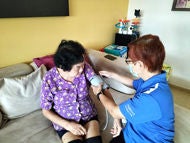What is - Nasopharyngeal Cancer (Nose Cancer)
What is nasopharyngeal cancer (nose cancer)?
Nasopharyngeal cancer (NPC), also known as nose cancer, is a disease in which cancer cells develop from the tissues of the nasopharynx.

How common is nasopharyngeal cancer (nose cancer)?
Nasopharyngeal cancer affects more men than women. In Singapore, NPC is the 10th most common cause of cancer death in males and one of the most common cancers in males aged between 30 and 49 years old. This cancer also tends to run in the family i.e. patients with relatives with NPC are at a higher risk of developing the cancer.
Symptoms of Nasopharyngeal Cancer (Nose Cancer)
What are the symptoms of nasopharyngeal cancer (nose cancer)?
In the early stages of nasopharyngeal cancer, there are often no or mild symptoms. When the cancer progresses, some symptoms may show.
- A painless neck lump
- Persistent blood stained saliva/sputum
- Bleeding/bloody discharge from the nose or in nasal secretions
- Nasal blockage that does not go away
- Hearing loss or ringing in the ears (often one sided)
- Persistent sensation of blocked ear/ears
- Unusual face pain or numbness
- Headache
- Double vision
- In advanced NPC, where the cancer has spread to other parts of the body such as the lung, bone or liver, symptoms such as breathlessness, cough or pain may surface
When should you see a doctor?
Make an appointment with your doctor if you have any signs or symptoms that worry you. If you have a strong family history of nasopharyngeal cancer (two or more first degree relatives with NPC), you may also wish to see a doctor to be screened for NPC.
Nasopharyngeal Cancer (Nose Cancer) - How to prevent
How is nasopharyngeal cancer (nose cancer) prevented?
There are several ways to lower the risk of nasopharyngeal cancer:
- Reduce consumption of salted and preserved foods
- Adopt a healthy diet with fruits, vegetables and whole grains
- Avoid smoking or inhaling second-hand smoke
- Exercise regularly and maintain a healthy weight
Nasopharyngeal Cancer (Nose Cancer) - Causes and Risk Factors
What are the risk factors for nasopharyngeal cancer (nose cancer)?
While the exact cause of nasopharyngeal cancer is unknown, several factors have been found to contribute to its development. These risk factors include:
- Gender – NPC is more common in men than in women
- A diet high in salted or preserved (cured/smoked/pickled) foods
- Epstein-Barr virus (EBV) infection
- Ethnicity – NPC more commonly affects people in parts of China and Southeast Asia. In Singapore, people of Southern Chinese heritage have higher incidence of NPC
- Family history of NPC
- Smoking
Diagnosis of Nasopharyngeal Cancer (Nose Cancer)
How is nasopharyngeal cancer (nose cancer) diagnosed?
Tests and procedures used to diagnose nasopharyngeal cancer include:
Nasoendoscopy
A thin, flexible camera tube called a nasoscope, is inserted through the nostril to check for any abnormalities such as bleeding or growths within the nasopharynx and the rest of the head and neck structures.Biopsy
If any abnormalities are seen during nasoendoscopy, a tissue sample may be collected (under local anaesthesia) for further examination in the lab.Imaging tests
Imaging tests (e.g., Computer Tomography (CT) scan or Magnetic Resonance Imaging (MRI) scans) may be ordered by the doctor to examine the head and neck region, nearby organs and lymph nodes for signs of cancer.
Blood tests
Blood tests to check for general health and infection, including how well the liver, kidney and other organs are functioning.
Staging scans
Positron Emission Tomography (PET) scan may be ordered. In this scan, a low-level radioactive substance is injected to determine if there is spread of cancer to the rest of the body. A CT scan of the chest and abdomen, and bone scan may also be used.
Treatment for Nasopharyngeal Cancer (Nose Cancer)
How is nasopharyngeal cancer (nose cancer) treated?
Treatment for nasopharyngeal cancer depends on the following factors:
- Size, type and location of the tumour
- Stage of the disease
- The patient’s general state of health
Radiotherapy/Radiation therapy
Chemotherapy
Surgery
Nasopharyngeal Cancer (Nose Cancer) - Other Information
|
Contributed by
The information provided is not intended as medical advice. Terms of use. Information provided by SingHealth.
Condition Treated At
Department
Oncologic Imaging
Department
Medical Oncology
Department
Radiation Oncology
Department
Surgery and Surgical Oncology, SGH & NCCS
Department
Otolaryngology (ENT)
Department
Otorhinolaryngology - Head &Neck Surgery
Department
Otorhinolaryngology- Head & Neck Surgery
Get to know our doctors at SingHealth Hospitals in Singapore.
Get to know our doctors at SingHealth Hospitals in Singapore. here.





















